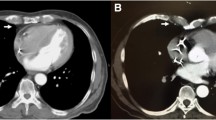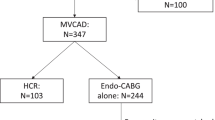Abstract
Currently, robotic-assisted coronary artery bypass grafting (RACABG) is a feasible choice for myocardial revascularization. Acceptable outcomes have been reported for RACABG with single target vessels; however, the long-term benefits of multivessel RACABG with composite arterial grafts have rarely been studied. Therefore, our study investigated the long-term results of multivessel RACABG with composite arterial grafts by reviewing the clinical data of patients from Taichung Veterans General Hospital. From December 2005 to June 2015, 562 patients underwent robotic-assisted robotic minimally invasive direct coronary bypass (MIDCAB) at Taichung Veterans General Hospital. Two major composite arterial graft configurations (i.e., inverted T-graft and Y-graft) were used. Data regarding the short-term and long-term outcomes of robotic-assisted MIDCAB were obtained from the medical records. For data regarding long-term outcomes of the patients not followed up at our institution, telephone interviews were conducted in June 2019. The in-hospital mortality rate and complication rate were 2.5% and 17.6%, respectively. We completed the follow-up for 486 patients (86.4%), and postoperative coronary imaging-based evaluation performed for 157 patients. The 5-year and 10-year survival rates were 82.7% and 65.2%, respectively. The 5-year and 10-year major adverse cardiac and cerebral events-free survival rates were 86.9% and 70.9%, respectively. The 5-year patency rate of various coronary anastomoses was 85.1–100%. Our study revealed that multivessel robotic-assisted MIDCAB with composite arterial grafts provided acceptable long-term outcomes, irrespective of the composite graft configuration.



Similar content being viewed by others
References
Cao C, Indraratna P, Doyle M et al (2016) A systematic review on robotic coronary artery bypass graft surgery. Ann Cardiothorac Surg. 5(6):530–543. https://doi.org/10.21037/acs.2016.11.08
Bonacchi M, Prifti E, Maiani M et al (2006) Perioperative and clinical-angiographic late outcome of total arterial myocardial revascularization according to different composite original graft techniques. Heart Vessels 21:69–77
Mannacio V, De Vita AD, Antignano A et al (2014) Y-grafts with the left internal mammary artery and radial artery. Mid-term functional and angiographic results. Cohort study. Int J Surg 12:952–957. https://doi.org/10.1016/j.ijsu.2014.07.008
Hwang HY, Paeng JC, Oh HC, Kim YH, Kim KB (2015) Comparison of perfusion and thickening between vein and right internal thoracic artery composite grafts from a randomized trial substudy. J Thorac Cardiovasc Surg 150:1187–1194. https://doi.org/10.1016/j.jtcvs.2015.08.009
Turner WF, Sloan JH (2006) Robotic-assisted coronary artery bypass on a beating heart: initial experience and implications for the future. Ann Thorac Surg 82:790–794. https://doi.org/10.1016/j.athoracsur.2006.03.112
Subramanian VA, Patel NU, Patel NC, Loulmet DF (2005) Robotic assisted multivessel minimally invasive direct coronary artery bypass with port-access stabilization and cardiac positioning: paving the way for outpatient coronary surgery? Ann Thorac Surg 79:1590–1596. https://doi.org/10.1016/j.athoracsur.2004.10.067
Srivastava S, Gadasalli S, Agusala M et al (2006) Use of bilateral internal thoracic arteries in CABG through lateral thoracotomy with robotic assistance in 150 patients. Ann Thorac Surg 81:800–806. https://doi.org/10.1016/j.athoracsur.2005.08.044
Tashiro T, Nakamura K, Iwakuma A et al (1999) Inverted T-graft: novel technique using composite radial and internal thoracic arteries. Ann Thoracic Surg 67:629–631. https://doi.org/10.1016/s0003-4975(98)01240-5
Bonatti J, Ramahi J, Hasan F et al (2016) Long-term results after robotically assisted coronary bypass surgery. Ann Cardiothorac Surg. 5:556–562. https://doi.org/10.21037/acs.2016.11.04
Kitahara H, Hirai T, McCrorey M et al (2019) Hybrid coronary revascularization: midterm outcomes of robotic multivessel bypass and percutaneous interventions. J Thorac Cardiovasc Surg 157:1829-1836.e1. https://doi.org/10.1016/j.jtcvs.2018.08.126
Casula R, Khoshbin E, Athanasiou T (2014) The midterm outcome and MACE of robotically enhanced grafting of left anterior descending artery with left internal mammary artery. J Cardiothorac Surg 9:19. https://doi.org/10.1186/1749-8090-9-19
Kappert U, Tugtekin SM, Cichon R, Braun M, Matschke K (2008) Robotic totally endoscopic coronary artery bypass: A word of caution implicated by a 5-year follow-up. J Thorac Cardiovasc Surg 135:857–862. https://doi.org/10.1016/j.jtcvs.2007.11.018
Bonatti JO, Zimrin D, Lehr EJ et al (2012) Hybrid coronary revascularization using robotic totally endoscopic surgery: perioperative outcomes and 5-year results. Ann Thorac Surg 94:1920–1926. https://doi.org/10.1016/j.athoracsur.2012.05.041
Serruys PW, Ong AT, van Herwerden LA et al (2005) Five-year outcomes after coronary stenting versus bypass surgery for the treatment of multivessel disease: the final analysis of the Arterial Revascularization Therapies Study (ARTs) randomized trial. J Am Coll Cardiol 46:575–581. https://doi.org/10.1016/j.jacc.2004.12.082
Mohr FW, Morice MC, Kappetein AP et al (2013) Coronary artery bypass graft surgery versus percutaneous coronary intervention in patients with three-vessel disease and left main coronary disease: 5-year follow-up of the randomised, clinical SYNTAX trial. Lancet 381:629–638. https://doi.org/10.1016/S0140-6736(13)60141-5
Adams C, Burns DJP, Chu MWA et al (2014) Single-stage hybrid coronary revascularization with long-term follow-up. Eur J Cardio Thorac Surg. 45:438–443. https://doi.org/10.1093/ejcts/ezt390
Acknowledgements
The authors would like to thank the nurse practitioners of the Department of Cardiovascular Surgery at the Taichung Veterans General Hospital for their efforts in collecting long-term follow-up data and conducting telephone interviews.
Funding
The authors declare that no funds, grants, or other support were received during the preparation of this manuscript.
Author information
Authors and Affiliations
Contributions
H-JW contributed to the study design and conducted the long-term follow-up program. All patients were operated by YC and C-LY. The clinical data collection and analysis were performed by C-LY and C-YL. The first draft of the manuscript was written by C-YL, and all authors commented on previous versions of the manuscript. All authors read and approved the final manuscript.
Corresponding author
Ethics declarations
Conflict of interest
The authors declare that they have no financial interests.
Ethics approval
The protocol of the study was reviewed and approved by the institutional review board of Taichung Veterans General Hospital as a minimal-risk retrospective study (approval no. CE20227A).
Consent to participate
The institutional review board of Taichung Veterans General Hospital regarded the study as a minimal-risk retrospective study and a waiver of informed consent was obtained.
Additional information
Publisher's Note
Springer Nature remains neutral with regard to jurisdictional claims in published maps and institutional affiliations.
Rights and permissions
About this article
Cite this article
Lo, CY., Yu, CL., Chang, Y. et al. Long-term results of robotic-assisted coronary artery bypass grafting with composite arterial grafts for multiple coronary anastomoses: 10-year experience. J Robotic Surg 17, 63–71 (2023). https://doi.org/10.1007/s11701-022-01391-z
Received:
Accepted:
Published:
Issue Date:
DOI: https://doi.org/10.1007/s11701-022-01391-z




